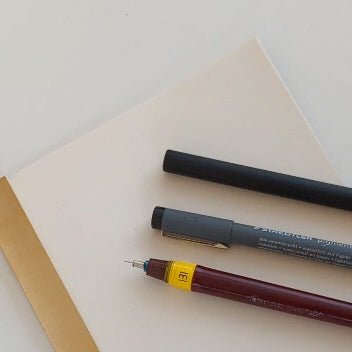One of the questions I often get asked is what are the differences between The Lumos, a fine liner and an Isograph pen? So, I thought I would write a blog post to explain their differences (and similarities).
Starting with the Isograph pen, this is a very clever pen and if you have one, I encourage you to use it because they can last a very long time. I am lucky enough to own a very old Rotring and while the plastic has started cracking slightly, which can happen eventually, if you look after it, it can last you a lifetime and it's refillable.

The Rotring has an ink cartridge that you can fill with a whole variety of inks including pigment ink and waterproof ink. The Rotring works by having a tiny little needle that sits in the tip of the pen. And when you press it down onto the page, a little plunger type mechanism allows ink to flow through the tip and onto the page. It's great.
I mean, it's what a lot of professionals use. One that says ISO on it means that it is a specific line width. So draughts men and women would use it to achieve a very specific line width. Complaints that I've heard are it can be scratchy and sometimes it can get clogged. So those are things to watch out for and it can be quite expensive to actually change the tip. Say you dropped that on the floor and it bent that tip, then you have to change the whole tip holding unit. So it does have its drawbacks and we'll get onto that when I start talking about the lumos.

This Staedler is your kind of classic fine liner pen. So there's a big reservoir that sits in here which has got pigment and waterproof based ink in, and then you can obviously get them in lots of different tip sizes. They're amazing pens.
I use them a lot when I design. The line widths are fantastic and the pigmented ink is lovely. So my main complaints around this and the reason I design the lumos are if that tip breaks, it writes it off, you can't use that pen anymore, which is a bit of a shame. And if you leave the tip exposed to the air, it'll dry out and this then becomes a disposable pen. Even if the pen survives long enough for the ink to run out, then you end up having to either send it to the drawer of shame where all the other pens that could have another life live, or it goes into the bin.
So that brings me onto The Lumos. The Lumos works very similarly to the fine liner in that it has a reservoir that sits in the body of the pen and you can refill that with any fountain pen friendly pigment ink, which has little nano pigment particles in it so it doesn't clog the pen.

So you can still use waterproof ink, lightfast ink and pigment ink, but you can also use any colour in your pen, which is an absolute treat. If the tip dries out, wears or is damaged, instead of having to throw away the pen, all you have to do is replace the tip. Plus, there are nine different tips you can choose from, including a lovely brush tip. I use Tom’s Studio fountain pen ink in my pen, and you can get that in a multitude of different colours. If I want a waterproof ink I use one of the sketchINKs range, which I stock on my website.
The fineliner tips are also really smooth on the page, so it means that there's less scratchiness when you're using a textured paper, and The Lumos Duo version means that you can have two different tips in the same pen. Obviously, I'm completely biased because I designed this pen, but I really love using both my Rotring and Staedler, I just wanted to improve on them so it's better for the user and better for the planet. I hope that answers your questions!

